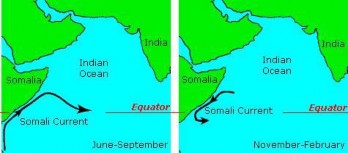3.2.3. Role of ENSO
The Indian monsoon is also influenced by EL-Nino, southern oscillation and Somalian current. We know that El Nino is the reversal of normal condition in the Pacific Ocean’s sea surface temperature. Though there is no direct correlation between bad monsoon and El Nino, but both are generally associated. There are years when India faced severe drought and those are not El Nino years and vice-versa. Southern Oscillation is the see-saw pattern of atmospheric pressure between the eastern and western Pacific Ocean. The oscillation has a period varying from 2-7 years. It is measured with Southern Oscillation Index (SOI) by measuring pressure difference between two points in Pacific Ocean (Tahiti and Darwin). A negative value of SOI implies high pressure over north Indian Ocean during the winter season and a poor monsoon.
The Somalian current changes its direction of flow after every six months. During the North- East Monsoon the Somali Current flows to the south-west, while during the South-West Monsoon it is a major western boundary current, comparable with the Gulf Stream (Figure 7). Normally, there remains a low pressure area along the eastern coast of Somalia. In exceptional years, after every six or seven years, the low pressure area in western Arabian Sea becomes a high pressure area. Such a pressure reversal results into a weaker monsoon in India.

